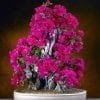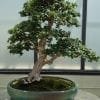It’s easy to understand why the green mound juniper bonsai is one of the most popular bonsai for novice growers. Compared to other bonsai, care and maintenance of the green mound juniper is relatively easy, and it naturally develops the beautiful hunter green leaves and tight growth pattern of classical bonsai.
These hardy trees are tolerant to a wide range of temperatures, and can be adapted to either indoor or outdoor growing.
| Scientific/Botanical Name | Juniperus procumbens |
| Description | Green mound juniper is an evergreen tree with leaves that are a gorgeous hunter-green color. It displays a tight, compact growth habit. |
| Position | Green mound juniper enjoys a moderate amount of indirect sunlight. This makes it highly suited to indoor cultivation. It will benefit from the low-intensity morning sun if it is given a north-eastern exposure, or kept on a north-facing windowsill. Do not expose the tree to full or direct sunlight under any circumstances. |
| Watering | Green mound juniper likes frequent watering, but it should be allowed to become a little dry before being watered. A number of factors will affect each plants watering schedule. Nevertheless, a good rule of thumb is to water the plant when the top one inch of soil has become dry. The most effect means of watering the tree is to place the pot with the tree into a sink or large bowl and add water up to the base of the tree trunk. Let the plant absorb water for a short period: approximately 30 to 60 seconds only. Remove the pot from the water and place it on a rack to ensure thorough drainage of excess water. |
| Feeding | The tree should be fed every two weeks with half-strength fertilizer from early springtime until late-fall. |
| Leaf and Branch Pruning | Pinching-out is the preferred form of pruning for the green mound juniper, and this should be undertaken throughout the spring season and the early part of the summer season. Pinch off new growth when it has reached a length of approximately half an inch. Do this by holding the shoot between the forefinger and the thumb, and giving it a sharp squeeze. |
| Re-potting & Growing Medium | Re-pot green mound juniper every second year until year six. After that, it will need to be re-potted every three or four years. Immediately after re-potting, give the plant a thorough watering and keep it in a darkened location for a few weeks. Re-potting should never be carried out during the period of dormancy, or during active growth. |
| Wiring | The tree tolerates wiring for shaping purposes, and the cascading style complements the natural growth of the tree. Wiring should only be undertaken when the growing season comes to an end, but before the dormancy period. This time frame minimizes the risk of damage to the trunk or branches. Nevertheless, any wiring should be closely monitored. |
| Notes | It is vital that the tree undergoes a period of dormancy each year. This is best achieved by putting the plant in an area where the temperature will remain below 60o Fahrenheit for three months at the very least. An unheated garage would be the ideal location. Even though the tree is hardy, it should be protected from strong winds and extreme frost if it is grown outdoors. |
Dormancy
Unlike some other species of bonsai, the green mound juniper requires periods of cold-weather hibernation to remain in stable health. To achieve dormancy, your juniper must be kept below 60 degrees Fahrenheit for a period of at least three months.
Remember, however, that because bonsai are more delicate than their full-grown counterparts, care must be taken to protect them from the elements.
During the winter months, place your bonsai in a cold frame, unheated garage, or other semi-protected environment. While the plant must be relatively cold to achieve dormancy, it should never freeze, or be exposed to strong winds or rain. Do not allow moisture to collect on the foliage or branches of your green mound juniper during its dormancy period.
Light Conditions
The green mound juniper bonsai flourishes under moderate, indirect sunlight, making it an ideal candidate for indoor growing. Position your bonsai in the morning sun, or place it in a North or South facing window to ensure that it receives sufficient amounts of low-level sunlight. Never leave your green mound juniper in full or direct sunlight.
Fertilization
During the growing season, which runs from early spring to late fall, your green mound juniper should receive regular fertilization, about twice per month. Remember that because the bonsai environment is an ecosystem in miniature, your tree does not require a full-strength treatment.
Particularly in the case of chemical fertilizers, it’s generally better to err on the side of caution and administer feedings at one-half the recommended strength for outdoor plants of comparable size.
Watering
Like all bonsai trees, the green mound juniper bonsai must be watered frequently; however, the green mound juniper grows best when allowed to dry slightly in between waterings.
The exact schedule for watering will largely depend on ambient temperature and humidity, but ideally the soil should be dry approximately one inch below the surface, while the bottom-most soil should remain damp.
To ensure that your bonsai receives water evenly, submerge it in a sink or basin until water just touches the base of the trunk. Allow the soil to soak for 30 seconds to 1 minute, and then place the tree on a rack to drain thoroughly.
Moisture
Compared to other bonsai, the green mound juniper prefers a relatively high level of humidity. A humidity plate can help promote a humid environment around the tree.
In addition to adding to the aesthetic appeal of your bonsai, moss placed around the soil can also help trap and release moisture, creating a moister environment for your green mound juniper.
Repotting
Like other bonsai, your green mound juniper will need to be repotted every other year until its sixth year, and every third or fourth year beyond that. Never repot your bonsai during its dormancy period, or during periods of heavy foliage growth.
In order to encourage your repotted green mound juniper to create new roots, water it well and withhold sunlight for a few weeks after repotting.
Wiring And Shaping
The green mound juniper naturally develops as a low-profile shrub, and is therefore perfect for cascading style bonsai. Wiring should always be done in the “off-peak” season, between the end of the growing season and the beginning of dormancy. During this period, it is unlikely that the trunk will develop sufficiently to cause cutting; however, wired trees should always be watched carefully.
Pruning
Pruning for the green mound juniper should take place primarily in the early months of the growth season, during spring and early summer. Unlike many other bonsai species, pruning the green mound juniper is accomplished almost entirely by pinching, rather than snipping.
New growth should be pinched off once it reaches approximately a half inch in length. In order to remove the growth, simply squeeze the shoot sharply between your forefinger and thumb.


